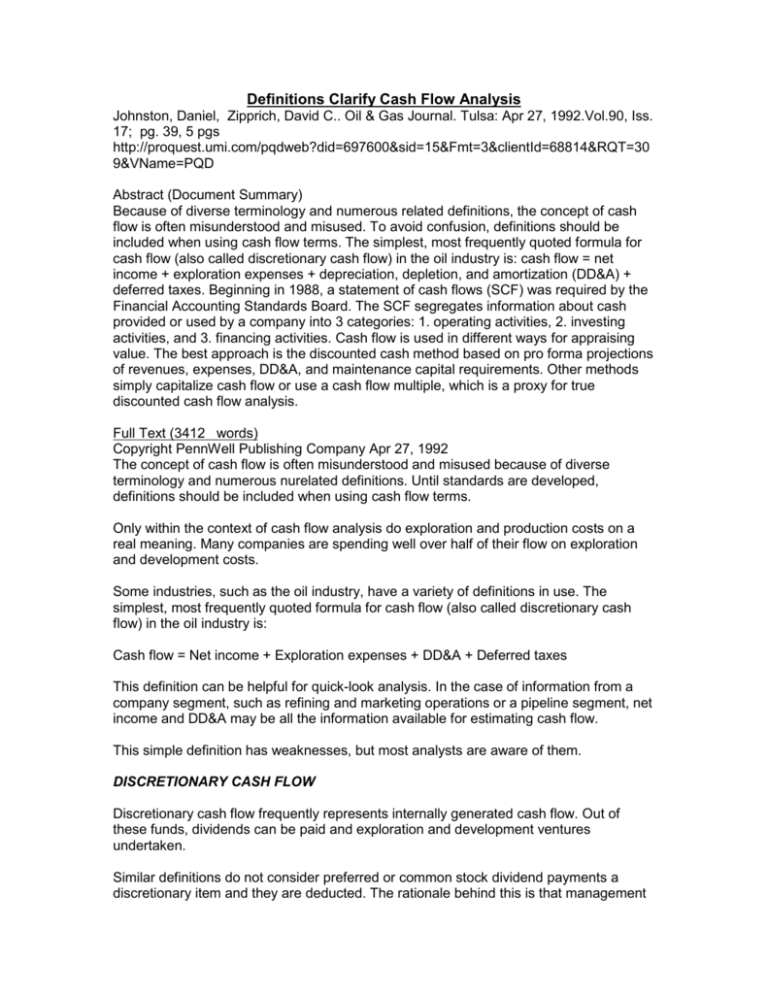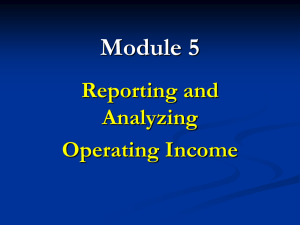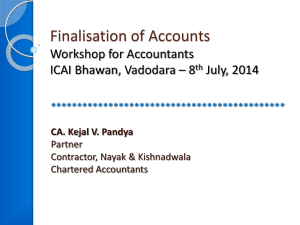Definitions Clarify Cash Flow Analysis
advertisement

Definitions Clarify Cash Flow Analysis Johnston, Daniel, Zipprich, David C.. Oil & Gas Journal. Tulsa: Apr 27, 1992.Vol.90, Iss. 17; pg. 39, 5 pgs http://proquest.umi.com/pqdweb?did=697600&sid=15&Fmt=3&clientId=68814&RQT=30 9&VName=PQD Abstract (Document Summary) Because of diverse terminology and numerous related definitions, the concept of cash flow is often misunderstood and misused. To avoid confusion, definitions should be included when using cash flow terms. The simplest, most frequently quoted formula for cash flow (also called discretionary cash flow) in the oil industry is: cash flow = net income + exploration expenses + depreciation, depletion, and amortization (DD&A) + deferred taxes. Beginning in 1988, a statement of cash flows (SCF) was required by the Financial Accounting Standards Board. The SCF segregates information about cash provided or used by a company into 3 categories: 1. operating activities, 2. investing activities, and 3. financing activities. Cash flow is used in different ways for appraising value. The best approach is the discounted cash method based on pro forma projections of revenues, expenses, DD&A, and maintenance capital requirements. Other methods simply capitalize cash flow or use a cash flow multiple, which is a proxy for true discounted cash flow analysis. Full Text (3412 words) Copyright PennWell Publishing Company Apr 27, 1992 The concept of cash flow is often misunderstood and misused because of diverse terminology and numerous nurelated definitions. Until standards are developed, definitions should be included when using cash flow terms. Only within the context of cash flow analysis do exploration and production costs on a real meaning. Many companies are spending well over half of their flow on exploration and development costs. Some industries, such as the oil industry, have a variety of definitions in use. The simplest, most frequently quoted formula for cash flow (also called discretionary cash flow) in the oil industry is: Cash flow = Net income + Exploration expenses + DD&A + Deferred taxes This definition can be helpful for quick-look analysis. In the case of information from a company segment, such as refining and marketing operations or a pipeline segment, net income and DD&A may be all the information available for estimating cash flow. This simple definition has weaknesses, but most analysts are aware of them. DISCRETIONARY CASH FLOW Discretionary cash flow frequently represents internally generated cash flow. Out of these funds, dividends can be paid and exploration and development ventures undertaken. Similar definitions do not consider preferred or common stock dividend payments a discretionary item and they are deducted. The rationale behind this is that management really does not have much latitude to consider dividend obligations a truly discretionary matter. The common definition of cash flow comes in various forms and disguises. Usually the terms cash flow and discretionary cash flow are used interchangeably. The previously given formula is consistent with most treatments of the concept of discretionary cash flow. The definitions box contains a collection of definitions that address a form of cash flow, but the terms and definitions appear dissimilar. With the exception of "Ebitxd," the terms and definitions in the box are consistent with what is usually called discretionary cash flow. However, while the simple definition of discretionary cash flow is useful and quick, there are more elaborate definitions. These include: Discretionary cash flow = Adjusted net income + (1 - t) x Exploration expenses + DD&A + Deferred taxes + (1 - t) x Research & development + (1 - t) x Interest expenses Free cash flow = Adjusted net income + (1 - t) x Exploration expenses + DD&A + Deferred taxes + (1 - t) x Research & development - Preferred dividends - Common dividends - Required maintenance capital where: DD&A = Depreciation, depletion, and amortization Adjusted net income = Net income adjusted for nonrecurring extraordinary events t = Tax rate (1 - t) = Tax adjustment for deductible expenses--either statutory or effective rates are used FREE CASH FLOW Cash flow as most definitions structure it, does not represent the true profitability of a firm much more than earnings. The treatment of depreciation is an important matter, and simply adding DD&A to net income should be considered in the proper light. The thought of a noncash item can be an obstacle because it is slightly abstract, but once the concept is grasped the door is open to an understanding of cash flow theory. The usual treatment of cash flow, adding all noncash items to net income, incorrectly ignores the need for replenishment of assets. There is sound reasoning behind DD&A. The best definitions of cash flow are those that acknowledge the need for capital to maintain a company as a going concern. Where a company decides to self-liquidate, a pure cash flow analysis that purposely ignores the need for capital infusion is appropriate. Free cash flow represents cash flow available after the necessary capital expenditures have been made to sustain a company's productive capacity. This treatment of what is known as maintenance capital is the fundamental difference between free cash flow discretionary cash flow. For an oil company, maintenance capital would include funds necessary to drill wells and maintain facilities such as refineries and pipelines. Most analysts ignore maintenance capital when doing a quick analysis, but they still know the importance of this item. Maintenance capital is virtually the opposite of DD&A. Required increases in working capital, as a company grows, are also considered a part of maintenance capital. CASH FLOW STATEMENTS Beginning in 1988, a statement of cash flows (SCF) was required by the Financial Accounting Standards Board (FASB), instead of its predecessor the statement of changes in financial position (SCFP). SCFs became effective for financial statements for fiscal years ending after July 1988. The SCF segregates information about cash provided or used by a company into three categories: 1. Operating activities (cash flow from operations) 2. Investing activities 3. Financing activities. The information included in the SCF for a company helps determine its: * Ability to generate future cash flows * Capacity to meet financial obligations * Success in investing strategies * Effectiveness in financing strategy. The arithmetic of the SCF is outlined in the calculations box. The cash flow from operations is the focus of most analysts. It represents the cashgenerating capability of a company's operating activities. CFFO Cash flow from operations (CFFO) is the net amount of cash taken in or lost from operating activities during a specific accounting period. The CFFO appears in the very first section of the SCF. The CFFO figure is sometime treated as cash flow although it is not the same as the cash flow figures nomally quoted. The main difference between CFFO and discretionary cash flow is the treatment of changes in the components of working capital. Most analysts do not explicitly address the changes in working capital for basic quicklook cash flow analysis. This is one reason why some companies will summarize net cash flows provided by operating activities before changes in components of working capital. This issue involving components of working capital is due to differences between accrual and cash accounting. ACCRUALS VS. CASH Revenue is recorded when it is earned, or is said to have accrued, and does not necessarily correspond to the actual receipt of cash. This concept is important for the understanding of the statement of cash flows and the concept of cash flow. For example, assume that a company sold 1,000 bbl of oil for $20/bbl, but had only received $17,000 by the end of the accounting period. From an accrual accounting point of view, revenues are recorded as $20,000. The calculation is: Revenues of $20,000 + Beginning receivables of $1,000 = Cash flow potential of $21,000 less ending receivables of $4,000 = Realized cash flow of $17,000 which is sales less increase in receivables The income statement would reflect $20,000 because the accrual method of accounting realized the income at the point of sale not at the point of actual cash exchange. The balance sheet would show the $17,000 increase in cash as well as an increase in accounts receivable for the $3,000 not yet received. However, the actual cash received is $17,000. This is why the SCF treats an increase in working capital as a reduction of cash flow. As a company grows, its working capital requirements also increase. Therefore, most detailed cash flow analyses include a negative adjustment for anticipated increases in working capital. EARNINGS VS. CASH FLOW Exploration, development, and production operations budgets, funded by cash flow, are often substantially greater than company earnings. Also the investment community does not overlook the importance and superiority of cash flow compared to earnings. Cash is king. Earnings and earnings multiples are quoted frequently because of the accessibility of these figures. But, most analysts focus on cash flow. The accounting methodology used in the oil industry can yield very different results on reported earnings depending on the method used. Companies that use successful efforts accounting methodology will expense unsuccessful exploration costs. Companies that use full cost accounting on the other hand will capitalize these costs and write them off over a number of accounting periods. By adding exploration expenses and DD&A to net income, the differences between SE and FC accounting begin to disappear. Cash flow analysis then begins to place companies on an equal footing for comparative purposes. A comparison is made of two otherwise identical companies under SE and FC accounting. The simplified income statements of the two companies, in the comparisons box, illustrate the importance of cash flow. The earnings for Company B are twice that of Company A, but Company A has more cash flow. The differences in accounting for depreciation will impact the taxes paid. Using before-tax net income is one way to place the two companies on a more equal footing for comparison. An important thing to consider here is that not all successful efforts companies treat dry hole costs in the same manner on the statement of cash flows. About half of the SE companies will add dry hole expenses as an adjustment to earnings in calculating CFFO. The other half do not. CALCULATING CASH FLOW Sometimes cash flow calculations may have adjustments that are specific to an industry or to a particular situation. A detailed cash flow analysis may include assumptions about changes in corporate strategy. Certain expenditures such as research and development expenses might be considered unnecessary, especially in a short-term financial crunch. Most analysts start with net income and make the necessary adjustments to arrive at cash flow. The main difference between cash flow and net income is in the adjustments that are made for noncash and nonrecurring items. Examples of the most common elements of cash flow are: * Extraordinary items that include loss on sale of assets, write-downs on book value of assets, and gain on sale of assets * Exploration expenses * Depreciation, depletion, and amortization (DD&A) * Deferred taxes * Research and development costs * Interest expenses. The box on p. 41 details the adjustments for calculating cash flow. CASH FLOW ANALYSIS Cash flow is used in different ways for appraising value. The best approach is the discounted cash flow method based on pro forma projections of revenues, expenses, DD&A, and maintenance capital requirements. Other methods simply capitalize cash flow or use a cash flow multiple which is a proxy for true discounted cash flow analysis. Capitalization of cash flow or the use of a cash flow multiple, are simplified approaches to estimating value. The use of a cash flow multiple is similar to an earnings multiple, but is nearly always more appropriate. A cash flow multiple is simply the stock price divided by cash flow per share. At least this is the most common usage. During 1990 most oil and gas companies traded at five to seven times cash flow. Rough estimates of the value of a company are often based on a multiple of one of the following: * Current period cash flow * A 1-year forecast * Average of past 3-year cash flow * Average of 3-year projected cash flow. A cash flow multiple of five implies a capitalization rate of 20%. Looking at this another way, if a company with steady cash flow was purchased for five-times cash flow, the internal rate of return for the transaction would be 20%. The basic formula for the present value of a cash flow stream is: PV = CF/(i - g) where: PV = Present value CF = Cash flow i = Interest rate or discount rate g = Growth rate For example, assume a company is currently generating $100 million/year in cash flow and the company cash flow stream is expected to grow at a rate of 4%/year. With a discount rate of 15%, the present value of the cash flow stream would be: PV = $100 million/ (0.15 - 0.04) = $909 million This example shows the relationship between interest and growth rates, cash flow and value, but it is not thoroughly practical. The formula assumes that the cash flow stream grows at a rate of 4%/year into infinity. Furthermore, from a shareholder point of view, not all cash is distributed in the form of dividends. In fact, only around 10% of cash flow generated by the oil industry is distributed in the form of dividends. One of the major weaknesses of using a cash flow multiple to quickly estimate value and compare companies is due to the various levels of debt used by companies. For example, a company may appear to be trading at a bargain at four to five times cash flow compared to other companies. However, by adjusting for debt in the capital structure, the differences in leverage can be accounted for. The formula for the debt adjusted cash flow multiple is: Debt adjusted cash flow = (Stock price/share + Debt/share)/(Cash flow/share) To illustrate the influence of debt on the cash flow multiple, assume that a company has a price of $40/share, a debt of $20/share, and a discretionary cash flow of $8/share. Then, the company's cash flow multiple not adjusted for debt is $40/$8 = 5. If adjusted for debt the cash flow multiple is ($40 + $20)/$8 = 7.5. This is a realistic example. Most oil companies are trading at a debt-adjusted cash flow multiple of seven to eight. Royalty trusts and master limited partnerships trade at closer to ten times cash flow. The oil industry stocks are currently trading at an average of eleven times free cash flow. Cash flow multiples can be helpful, but also bear the risk of confusion. This is because most quoted cash flow multiples are not adjusted for debt, and the kind of cash flow calculation used is commonly not disclosed. THE SPECTRUM OF CASH FLOW DEFINITIONS * Discretionary income (Enron Oil & Gas, 1989 Annual Report) is net income (loss) adjusted to eliminate the effects of DD&A, lease impairments, deferred taxes, property sales, other miscellaneous noncash amounts, and exploration and dry hole expenses. * Discretionary cash flow (Maxus Energy Corp., 1990 Annual Report) is net income (loss) plus noncash items and exploration expense, reduced by preferred dividends. * Discretionary cash flow (Oryx Energy Co., 1990 Annual Report) is the cash from operating activities, before changes in working capital, plus the cash portion of exploration expenses. * Operating cash flow (Snyder Oil Co., 1990 Annual Report) in net income before DD&A and deferred taxes. * Cash from operations (Apache Corp., 1990 Annual Report) is cash flow from operating activities before changes in components of working capital. * Working capital provided by operations (Berry Petroleum Co., 1990 Annual Report) is effectively cash flow from operations (CFFO) before changes in working capital. * Cash Flow before balance sheet changes (Devon Energy Corp., 1991 Annual Report) is CFFO before changes in components of working capital. * Net operating cash flow (Edisto Resources Corp., 1991 Annual Report) is net loss as adjusted for depreciation, depletion, amortization, abandonment, and exploration costs, plus losses on asset sales. * Operating cash flow (Sanford C. Bernstein & Co. Inc.) is net operating income plus DD&A plus deferred taxes plus exploration expense. * Cash flow (Wertheim Schroder & Co. Inc.) is adjusted net income plus DD&A plus after tax exploration expense (which was determined by applying actual or statutory tax rates to the current year charge). * Ebitxd (First Boston) are earnings before interest, taxes, exploration expense, and DD&A. ADJUSTMENTS FOR CALCULATING CASH FLOW NET INCOME ADJUSTMENTS Net income is the first component of cash flow analysis. Adjustments may be required for extraordinary one-time events that impact net income. One of the more common adjustments is for a gain or loss on the sale of assets. The analyst looks for these in the income statement or the statement of cash flows. Further adjustments would be necessary to project future earnings and cash flow if income-generating assets had been sold. EXTRAORDINARY ITEMS The extraordinary items such as a loss or a gain on the sale of assets, or write-downs on book value of assets, are excluded from most cash flow calculations. This is because these one-time nonrecurring events are not considered to be part of the normal course of business. Book losses or write-downs on the book value of certain assets do not actually deprive the corporation of cash. When earnings reflect nonrecurring income that has resulted from the sale of assets, adjustments must be made to quantify the true cash generating ability of the company without these extraordinary items. Adjusted net income = Net income -Gain on sale of assets + Loss on sale of assets + Write downs or lease impairments The objective in cash flow analysis is to try to eliminate the effects of such events to get a picture of the actual cash generating capability of a company. Some extraordinary items are noncash in nature and some actually either provide cash or deplete the company's cash resources. The key element is whether or not the event is an isolated incident and if future cash flow will be impacted. For example, the income from a one-time sale of an unprofitable business segment may be excluded from the cash flow calculation. However, the anticipated increase in profitability should be factored into cash flow forecasts. EXPLORATION EXPENSES In the oil industry, exploratory dry hole expenses are commonly added back to net income when calculating cash flow. By adding in the exploration expenses, one of the major differences between full cost and sucessful efforts accounting is offset. Companies can be compared for their cash flow generating capability. DD&A Depreciation, depletion, and amoritization are usually the most significant cash flow variables. The misuse and misunderstanding of the concept of cash flow comes from focusing on the noncash aspect of DD&A. DD&A is a valid cost. Depreciation expense for a computer purchased 3 years ago would be a noncash item, but soon it will be time to replace the equipment. This highlights the most important aspect of cash flow theory. Many people appropriately treat DD&A as a noncash item but forget that it should match capital requirements to keep a company going. There are three different aspects to depreciation: 1. Depreciation for tax purposes, usually some form of accelerated depreciation. 2. Accounting depreciation, usually some form of straight line, sometimes accelerated explained in the footnotes. 3. Economic depreciation comes from physical depletion, deterioration, and technological obsolescence. Economic depreciation is a fact of life that cannot be ignored. To evaluate a company as a going concern this aspect must be considered. To perform cash flow analysis by simply adding back depreciation ignores economic depreciation. The difference between depreciation for tax purposes and financial accounting depreciation is the birthplace of deferred taxes. DEFERRED TAXES Companies can keep two sets of books, one for financial accounting and the other for determining income taxes. The tax item on the income statement is the result of the difference between what the taxes would be under financial accounting-vs.-tax accounting using accelerated depreciation allowed by the government. Deferred taxes are not an actual payment of taxes to the government. In reality, the company actually still has the money, and may not have to pay the deferred taxes for some time. Because of this, the deferred tax account on the balance sheet is viewed as an interest free loan from the government. Most analysts will add deferred taxes during the accounting period to earnings and other noncash items to calculate cash flow. The statement of cash flows (SCF) also treats deferred taxes in this fashion. R&D A company's research and development (R&D) expenditures are often viewed as a component of cash flow. This is because these costs are not core to the operations cash flow generation. R&D is considered a true discretionary item and adding R&D expenses to net income places companies with different R&D postures on equal footing. INTEREST EXPENSE Another common adjustment to cash flow is to add the interest expense and evaluate the company cash flow capability before debt service. This neutralizes most of the influence of leverage and places companies with different levels of debt on equal footing. Companies that have higher interest and exploration expenses have relatively lower taxes and further adjustments are made to account for this. TAX ADJUSTMENTS When interest expense is included in the cash flow calculation, it should be tax adjusted. This is because interest is deductible for calculating taxes. Either statutory rates are used or sometimes an effective rate is used. Exploration expenses should be treated the same way. Simply adding these expenses to adjusted net income will overstate cash flow. The items are multiplied by one minus the tax rate used. Tax adjusted interest expense = i x (1 - t) where: i = Interest expense t = Tax rate (statutory or effective)








